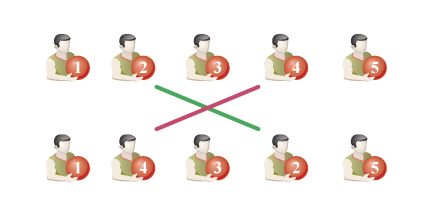「CF316D3」PE Lesson
题解
显然,答案与ci中1和2的个数有关,设其分别为a,b
若b=0,则每个置换群的大小都是1或2,方案简单dp即可
把这些置换群看成自环和二元环(有向),考虑加入剩下b个元素,每个元素可以插入到一条边中或者独自成环
所以
\[f_a=f_{a-1}+(a-1)f_{a-2}\] \[ans=f_a \prod_{i=a+1}^{a+b} i\]
|
1 2 3 4 5 6 7 8 9 10 11 12 13 14 15 16 17 18 19 20 21 22 23 24 25 26 27 28 29 30 31 32 33 34 35 36 37 |
#include<map> #include<set> #include<cmath> #include<cstdio> #include<cstring> #include<vector> #include<iostream> #define mod 1000000007 #define ll long long using namespace std; ll read() { int x=0,f=1;char ch=getchar(); while(ch<'0'||ch>'9'){if(ch=='-')f=-1;ch=getchar();} while(ch>='0'&&ch<='9'){x=x*10+ch-'0';ch=getchar();} return x*f; } int n,a,b; ll f[1000005],ans; int main() { n=read(); for(int i=1;i<=n;i++) { int x=read(); if(x==1)a++; else b++; } f[0]=1;f[1]=1; for(int i=2;i<=a;i++) f[i]=(f[i-1]+f[i-2]*(i-1))%mod; ans=f[a]; for(int i=a+1;i<=a+b;i++) ans=ans*i%mod; printf("%d\n",ans); return 0; } |
Subscribe


